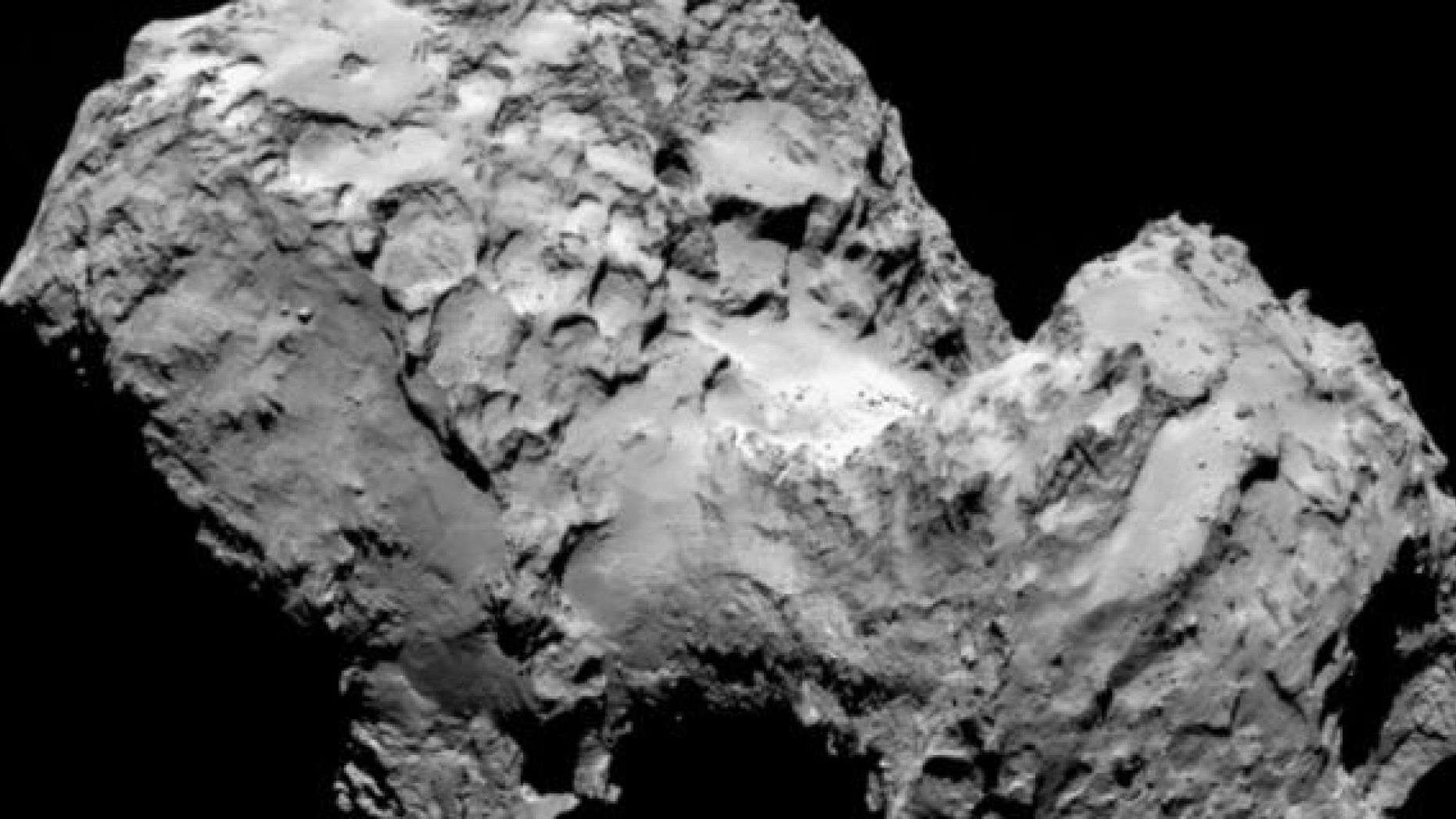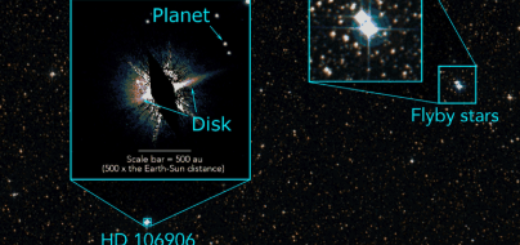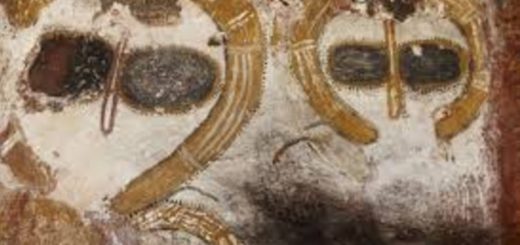Wild new alien theory emerges

In this picture taken on Aug. 3, 2014 by Rosetta’s OSIRIS narrow-angle camera Comet 67P/Churyumov-Gerasimenko is pictured from a distance of 285 kms. A mission to land the first space probe on a comet reaches a major milestone when the unmanned Rosetta spacecraft finally catches up with its quarry on Wednesday Aug 6, 2014. It’s a hotly anticipated rendezvous: Rosetta flew into space more than a decade ago and had to perform a series of complex maneuvers to gain enough speed to chase down the comet on its orbit around the sun. The image resolution is 5.3 metres/pixel. (AP Photo/ESA/Rosetta/MPS for OSIRIS Team ) (The Associated Press)
It’s beginning to look like life here began out there. The number of potentially habitable worlds has exploded. Organic molecules are being found in comets and cosmic clouds. So is there an interstellar conveyor belt seeding life throughout the galaxy?
Monash University’s Professor John Lattanzio has told the annual meeting of the Astronomical Society of Australia hosted at Swinburne University this week that he thinks this may be so.
The idea is called panspermia.
There is as yet no ‘smoking gun’ that life on Earth is an offshoot of interstellar spores.
But there are enough clues floating about to make the concept enticing.
“A series of astronomical observations obtained over the period 1986 to 2018 supports the idea that life is a cosmic rather than a purely terrestrial or planetary phenomenon,” Professor Lattanzio says.
“These include the detection of biologically relevant molecules in interstellar clouds and comets, mid-infrared spectra of interstellar grains and the dust from comets, a diverse set of data from comets including the Rosetta mission showing consistency with biology and the frequency of Earth-like or habitable planets in the Galaxy.”
He says these clues all converge on the idea that comets being cast about on the interstellar winds can carry with them their own active biology – and not just the chemical building blocks of life.
But there’s only one way to test the idea.
Find life somewhere else.
And we’re working on it.
Professor Lattanzio reported on work done by an international team of researchers who have come up with a set of specific predictions about the nature of extraterrestrial life if it is discovered on Enceladus, Europa or beyond.
Mostly, they don’t expect it to be fundamentally different to our own.
If it is, the concept goes out the window.
“A radically different biochemistry elsewhere can be considered as a falsification of the theory of interstellar panspermia,” he says.
FOLLOW THE EVIDENCE
The idea that the cosmos is an active promoter of life dates back to the Greek astronomer Aristarchus of Samos, who lived in the 3rd century BC. He believed “spermata” – the seeds of life – are everywhere in the universe.
The concept was picked up by Lord Kelvin and presented to the British Society for Advancement of Science in 1871. It was supported by the late Professor Stephen Hawking. The modern version of panspermia was developed by Professors Fred Hoyle and Chandra Wickramasinghe, the latter being part of the team reporting the latest developments at the Australian meeting.
“The modern version of panspermia got a major boost when Australian astronomers Dayal Wickramasinghe and David Allen measured the way light was absorbed by interstellar dust,” Professor Lattanzio says. “Hoyle and Chandra Wickramasinghe (Dayal’s brother) showed that this was matched almost perfectly by desiccated E. coli bacteria. This was unexpected, of course.”
The panspermia argument goes that there is insufficient direct evidence supporting the theory that a chance chemical accident sparked the origins of life on Earth about 4 billion years ago. This theory is called abiogenesis.
That organic material falls to Earth from space is now generally accepted. It’s been found in meteorites. The Stardust recovery mission found organics and glycine – one of the simplest amino acids.
Then Rosetta mission to 67P/Churyumov–Gerasimenko found abundant oxygen (02), ozone (03) and methanol scattered among the comet’s ice.
“These cannot co-exist in equilibrium together,” Professor Lattanzio says, “and are consistent with active biological processes”.
Phosphorus was also found on 67P. And this is a vital ingredient of RNA and DNA. And the concentrations it was found in are ten times higher than occur elsewhere in the solar system, and are “consistent with biological processes and concentration mechanisms,” he says.
And we now know comets can cross the interstellar voids.
“We thought comet and asteroids traveling between stellar systems would be rare because of the distances involved,” Professor Lattanzio says. “But now we have detected an example, in Oumuamua. The fact that we found an example so soon after developing telescopes argues that they must be rather more common than we thought.”
SMOKING GUNS?
Would a fossilized alien be compelling evidence?
Professor Lattanzio thinks so.
But there’s a problem.
We’re talking fossilized bacteria.
They’re small. They’re delicate. And the possibility remains that some unknown geological process may look like them.
But as science and technology improve, we’re getting better at sifting the evidence.
Now NASA says it has found fossilized ‘extraterrestrial nucleobases’ – or basic nitrogen-carrying biological molecules – in two enticing meteorites (Murchison and Lonewolf Nanataks 94102). Amino acids have also been found in the Murchison meteorite, including nine previously unknown types.
While this scattering of clues are in meteorites that have already reached Earth, there are plenty more up there circling our star.
There’s Methyl Chloride (CH3CL). On Earth, it’s only made through biological processes – including microalgae living in oceans with or without light.
Astronomers examining distant exoplanets have already suggested the presence of Methyl Chloride would serve as a ‘biomarker’, a strong sign of the existence of life. Now it has been found by the Rosetta mission in comet 67P.
Then there’s alcohol. It’s undoubtedly been affecting the wits of astrobiologists since it was first found on comet Lovejoy. To be exact, Lovejoy is carrying ethyl alcohol (ethanol) and sugar.
“Lovejoy is emitting the equivalent of 500 bottles of wine per second,” Professor Lattanzio says. “Of course bacteria produce ethanol from sugars …”
But the idea that ‘actual biological entities’ – such as cyanobacteria – can be transferred between worlds by comets remains controversial.
While the evidence is consistent with the idea of panspermia, it’s not yet compelling.
“No wonder the proponents of panspermia get frustrated,” Professor Lattanzio says.
A MATTER OF SURVIVAL
Professor Lattanzio says panspermia does not explain the origin of life.
But the implications would be enormous.
“Knowing it did not arise here would be an important discovery,” he says.
“Good science does not say there is no mechanism for this. Good science says: ‘Is there a phenomenon to explain?’ If so, then we do need to find a mechanism.”
So is the idea that biology can cling to life on a comet in the deep, dark – and immensely cold – voids between stars even possible?
Professor Lattanzio says … possibly.
“We used to think microbes could not survive in space. Direct evidence now contradicts this.”
He points to a recent experiment on the International Space Station. Antarctic rocks carrying bacterial colonies were exposed to space. After a year-and-a-half, samples were retrieved and rehydrated. Green alga and a pink fungus quickly emerged.
And then there’s the dust that has been accumulating on the exterior of the ISS since it went into orbit in 1998. It was found to contain the DNA of land and marine bacteria.
So, possibly through weather and electrical storms, we can see life being kicked back out into the ionosphere from the surface of our own planet. But it is also plausible that it arrived with interplanetary dust.
How could it hitch-hike through the immense cold between the stars?
Bacteria have been discovered that can survive regular freeze-thaw cycles, and continue to metabolize at temperatures as low as -20C. But warmth may not be as big a problem as it’s made out to be.
Professor Lattanzio points out the slow, but steady decay of natural radioactive substances produces significant heat. It powers geological processes on planets and moons.
It’s possible, he argues, that comets bigger than 400km across could, therefore, have liquid cores, no matter how far from a warming star they were.
And liquid water, with a good mix of minerals, is an ideal travelodge for hitchhiking bacteria.
And tests indicate bacterial colonies could even survive the flare and crash of a comet into our atmosphere.
“There’s a small but finite survival fraction,” Professor Lattanzio says. “That is all bacteria needs. They reproduce very quickly.”
But how could we tell such life was alien, or merely Earth-based contamination?
Panspermia itself says life down here would be hard to distinguish from that found up there.
Professor Lattanzio says the only option is to find life on Mars, Enceladus or Europa, and examine its makeup.
“If we discover life with radically different biochemistry to that found on Earth, then that would rule out panspermia,” he says.
“Nothing I have told you is compelling evidence for panspermia. But there are some odd coincidences that we should consider.”
This story originally appeared in news.com.au.



 Creators of mankind
Creators of mankind Description of “Tall white aliens”
Description of “Tall white aliens” Where they came from?
Where they came from? About hostile civilizations
About hostile civilizations The war for the Earth
The war for the Earth “Tall white aliens” about eternal life
“Tall white aliens” about eternal life Video: “Nordic aliens”
Video: “Nordic aliens” Aliens
Aliens Alien encounters
Alien encounters The aliens base
The aliens base UFO
UFO Technology UFO
Technology UFO Underground civilization
Underground civilization Ancient alien artifacts
Ancient alien artifacts Military and UFO
Military and UFO Mysteries and hypotheses
Mysteries and hypotheses Scientific facts
Scientific facts


















